Introduction to Anime in US Pop Culture
Daniel Baird
Even if you have never watched anime, you probably have heard of it and know someone who does watch. From the ever-popular Pokémon franchise to the more recent Demon Slayer movies, anime has become part of our cultural consciousness. In short, anime is part of our pop culture. And it is a big part of our culture. In the US alone, Pokémon: The First Movie—Mewtwo Strikes Back grossed over $85 million with $50 million of that coming in the first five days of its US release in 1999. And anime’s role in our culture has only grown since the first wave of Pokémon struck the US.
Below is a brief history of anime as well as a discussion of anime marketing categories and an introduction to some of the problems of censorship that plagued anime as it made its way to the US.
History of Anime
Animation, or the act of making drawings appear to move, has been around for a long time. Consider, for example, that Mickey Mouse first came out in 1928. But we are interested in a particular form of animation, known as anime, which had its origins in Japan. Anime was born in 1963 with Astro Boy based on a manga (Japanese comic book) of the same name. Osamu Tezuka (1928–1989) was the author and producer and today is revered as the “God of manga.” This isn’t to say that there wasn’t animation in Japan prior to Astro Boy—cartoon movies and educational material had been produced since the advent of cinema—but Astro Boy was the first TV serial animation, and Tezuka himself coined the word “anime” to describe his animated TV series. It was a big success. Astro Boy also became the first anime exported to the US.
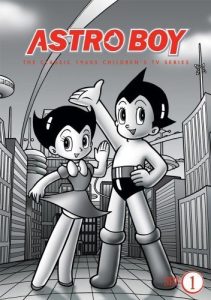
used pursuant to Fair Use.
New technical skills and genres soon followed Astro Boy. For example, Kimba, The White Lion (1965–66) was the first to go full color and was brought to the US in 1966. Sally the Witch (1966–68) is considered the first of the magical girl genre and is the first anime marketed specifically to girls rather than children in general. (The manga author, Mitsuteru Yokoyama, stated that she was inspired by the US sitcom Bewitched.) Speed Racer (1967–68) was released almost simultaneously in Japan and the US and capitalized on both the popularity of auto-racing and James Bond–esque gadget cars. Finally, the 1964 Tokyo Olympics was followed by the first sports anime, Star of the Giants (1968).
The 1960s also began the long collaboration between US producers and companies with Japanese animation studios. Two famous shows produced in early collaboration include Rudolph Red-Nosed Reindeer (1964) and Frosty the Snowman (1969). The ever-popular Transformers (1985) was originally a collaboration between US and Japanese toy companies.
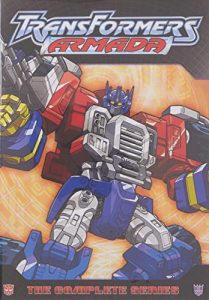
used pursuant to Fair Use.
The 1970s saw several important changes in animation. Both live-action and anime shows started having five-member bands of heroes fighting a different monster each week. Five originally came from the five cardinal colors of the Chinese elements but were altered slightly for purposes of TV: red, pink, blue, yellow, and black with pink replacing the original Chinese white. More importantly having five main characters and a monster of the week meant that toymakers could sell more merchandise related to a show. Mazinger Z (1972–74) introduced the idea of having pilotable machines rather than robots, which is now a staple genre in anime.
Two shows in the 1970s are credited with bringing in more mature themes and a teen audience. The first was Star Blazers (1979–1984, in Japan known as Space Cruiser Yamato 1974–1975) and the second was Mobile Suit Gundam (1979–1980). Star Blazers initially did well in the US and created a fanbase for anime. It was Gundam, however, that introduced harsher themes of war, gave realistic motivations for characters to fight, showed how characters suffered while fighting, and gave explanations as to how the mechanized machines worked and why there would be teenage pilots. In doing so, Gundam created what is known as the “real robot” genre. Gundam, however, did not make it to the US until 2000 when another show from the franchise, Gundam Wing (1995), became popular. But the merchandising and numerous spin-offs and sequels (50 plus!) to the original Gundam has made it one of the larger anime-related franchises.
VHS in the 1980s and DVDs in the 1990s opened a new market for anime. This in turn helped create a fandom that could not only buy toys but now could own their favorite shows. The late 1980s and early ’90s saw the founding of US anime and manga distributors and magazines. And there were shows that attracted the anime fans such as the post-apocalyptic biker show Akira (1988), the angsty Evangelion (1995), and a post-human theme in Ghost in the Shell (1995).
But it was one franchise that made anime in the US mainstream: Pokémon (1997–present). Originally a video game released in 1996, Pokémon soon made its way into trading cards, anime, and movies. Within one year of its release in the US, Pokémon games “had earned $5 billion—roughly a cumulative equivalent to the size of the entire U.S. game industry that year—all by itself” (Alt 226). The movie, Pokémon: The First Movie—Mewtwo Strikes Back (1999), still holds the record for the highest grossing anime in the US.
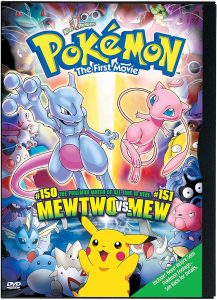
used pursuant to Fair Use.
This led to an explosion of anime and related marketing goods in the US. Cartoon Network’s Toonami (1997–2008) was aimed at 9–15-year-olds and featured a lot of anime including Dragon Ball Z (1989–96), Sailor Moon (1992–1997), Cardcaptor Sakura (1998), Gundam Wing (1995), Tenchi Muyo (1995), and later Cowboy Bebop (1998–1999). Of these, “Dragon Ball Z is the #1 selling anime brand of all time, with over 25 million DVDs and Blu-rays sold in the United States alone” (Stuckmann 100).
The early 2000s saw the height of US companies pouring money into Japanese animation companies as well as the greatest number of titles released both in Japan and in the US. This in many ways represent a golden age for anime. In 2003 Hayao Miyazaki won the only Oscar presented for an anime: Spirited Away (2001).
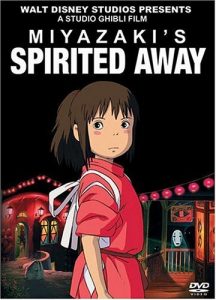
used pursuant to Fair Use.
In 2006, Crunchyroll was established and has become one of the largest anime and manga distributors outside of Japan. The golden age ended by 2010 and shrinking US investment meant less anime being produced in Japan and in the US. And many lament what continued to be produced was not as original in content.
But with mainstream streaming services such as Amazon Prime and Netflix now showing anime, it is easier than ever to find and watch. And more recently, Crunchyroll and other companies have aired Korean- and Chinese-produced animation and have produced or co-produced original content. Things are looking up once again for anime fans.
Overview of Anime Categories
Which then brings me to the need to explain a few things about the differences between anime and what we normally consider cartoons in the US. Manga (and by extension anime) in Japan is marketed to certain audiences. A simple categorization is as follows:
Children’s
This category is very similar to what we in the US think of cartoons, generally aimed at roughly 11 and younger; they have simpler plots, clean humor (relatively) and avoid violence and sexuality (again, relatively); stories can contain a moral and are usually a single episode in nature rather than a story that spans multiple episodes—or even multiple short stories in a single episode; and finally this category can be aimed at boys, girls, or both. Examples include Astro Boy (1963), Hello Kitty (1987, 1989, etc.), and Doraemon (1973, 79, 2005).
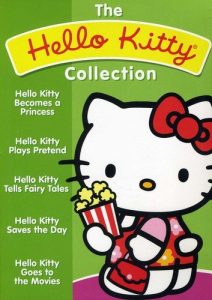
used pursuant to Fair Use.
Shōnen
Marketed towards boys ages 12–18 and the most popular sub-genre of anime, these often focus on high action such as fighting, mecha (robot), or sports. It also includes the ever-popular harem show (where the protagonist is introduced to and accompanied by an all-female support cast representing different personalities). Protagonists tend to be the same age as the audience. Some historically important shōnen anime include Dragon Ball Z (1989), Naruto (2002–2017), My Hero Academia (2016–present), and Demon Slayer (2019–present).
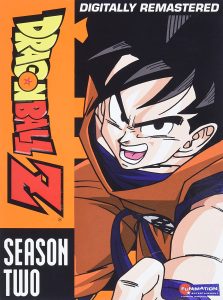
used pursuant to Fair Use.
Shōjo
Marketed towards girls ages 12–18, these generally feature romance although the genre itself can vary widely with the romantic comedy and magical girl being common. Examples include Sailor Moon (1992), Cardcaptor Sakura (1998), and Fruits Basket (2001, 2019—an example of a reverse harem where the protagonist is surrounded by an all-male cast of different personalities; unlike the male harem show, the female harem show often has at least one female love rival to the protagonist).
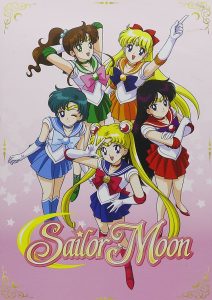
used pursuant to Fair Use.
Seinen
Created for men generally age 18–45, this category is much harder to define as it covers such a wide range. The protagonists tend to be either college age or working—the office worker is a common protagonist. But watch out! Seinen stories include those focused on teens as well such as Kaguya-Sama: Love Is War (2019–present). Unlike in US adult cartoons, the seinen genre may not necessarily include graphic violence, profanity, or sexual content; rather it is usually that the plot is more complex and may include thought-provoking political and/or social commentary. That it not to say that some aren’t violent and sexually explicit. Examples include Ghost in the Shell, Master Keaton (1998–1999), and March Comes in Like a Lion (2017–2018).
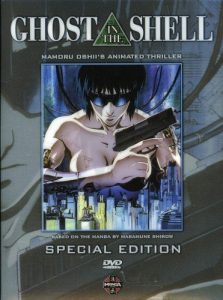
used pursuant to Fair Use.
Josei
These anime are created for women 18–45. Romance is still very common but less idealized than what you find in shōjo; like the seinen, they tend to be more sophisticated with the protagonist from the same age group as the audience but again—surprise!—you will still find stories about teens such as the very popular Chihayafuru (2011–2020). Josei manga/anime with few exceptions has received little attention in the US. Examples include Bunny Drop (2011), Nodame Cantabile (2007–2008), and Honey and Clover (2005–2006, originally began as shōjo before being rebranded for josei).

used pursuant to Fair Use.
These definitions are not meant to be inclusive, just an introduction. And yes, there are manga/anime aimed at even older audiences, but these categories haven’t made their way to the US.
Censorship
In the US much of the nuance of these categories is lost, especially before the 2000s when most everything was sanitized and recategorized as children’s cartoons. The first type of censorship that was prevalent resulted from the idea that anime is simply children’s cartoons. As early as the late 1960s, anime in Japan was pushing beyond the idea of just for children—even with Astro Boy, about half of the final season was never shown in the US because it was deemed too dark for child audiences. While in Japan much anime through the 1980s and 1990s were being aimed at teen and even older audiences, in the US anime kept being rebranded for children. This led to considerable censorship. For example, blood and nudity were edited out of Dragon Ball Z and homosexuality was removed from Sailor Moon.
The second type of censorship was localization, or in other words removing anything that would hint at the Japanese origin of the anime. This was due largely in part with the earliest anime arriving within the two decades after WWII and the lingering anti-Japanese sentiment in the US. Names were changed, episodes rearranged or dropped altogether. Speed Racer (1967), although popular in the US, like other anime had heavy editing including changing the title and characters’ names to eliminate any association with Japan. Likewise, the average US viewer didn’t know that the original title of Star Blazers (1979) was actually Space Battleship Yamato—a reference to the Japanese Yamato class of battleships in WWII. Robotech (1985) is the most infamous example since it was actually crafted out of three different anime: Super Dimension Fortress Macross (1982), Super Dimension Cavalry Southern Cross (1984), and Genesis Climber MOSPEADA (1983). As anime became more popular and the memory of WWII faded, this need to remove the Japanese origin eventually diminished, but it lingered into the 2000s as names and titles continued to be changed.
Conclusion
Anime is now part of US popular culture. Its influence is obvious in US cartoons such as Avatar: The Last Airbender (2005) or Teen Titans (2003). It is seen with the introduction of anime at conventions followed by the creation of anime-specific conventions, cosplay, and fan adaptations. And whether you are a casual fan or a hardcore fan, there is a plethora of ways to watch anime. As with any pop culture, there is an intertextuality, a way of referencing shared experiences whether through a fan-made Dragon Ball Z video on Youtube or maybe catching a concert of the J-Pop sensation Hatsune Miku, who is a digital character projected on a screen with a human backing band. Regardless of what you think of anime, you can’t escape its cultural presence.
Further reading and resources
Alt, Matt. Pure Invention: How Japan’s Pop Culture Conquered the World. Crown, 2021.
Clements, Jonathan. Anime: A History. British Film Institute. (Originally published 2013) Bloomsbury, 2018.
Clements, Jonathan and Helen McCarthy. The Anime Encyclopedia 3rd Revised Edition: A Century of Japanese Animation. Stone Bridge Press, 2015.
Denison, Rayna. Anime: A Critical Introduction. Bloomsbury Publishing, 2015.
Galbraith, Patrick W. The Moe Manifesto. Tuttle Publishing, 2014.
Galbraith, Patrick W. Otaku and the Struggle for Imagination in Japan. Duke University Press, 2019.
Hintz, Carrie and Eric L. Tribunella. Reading Children’s Literature: A Critical Introduction. 2nd Edition. Broadview Press, 2019.
MacWilliams, Mark W., editor. Japanese Visual Culture. Taylor and Francis, 2008.
McCarthy, Helen. Hayao Miyazaki: Master of Japanese Animation. Stone Bridge Press, 1999.
Miller, Vincent. Japanese Pop Culture: Discovering the Fascinating Japanese Pop Culture—The Land of Manga and Anime. Dingo Publishing, 2019.
Napier, Susan. Anime from Akira to Howl’s Moving Castle: Experiencing Contemporary Japanese Animation. 2nd edition. St. Marti’s Griffin, 2005.
Stuckmann, Chris. Anime Impact: The Movies and Shows that Changed the World of Japanese Animation. Mango Publishing Group, 2018.

